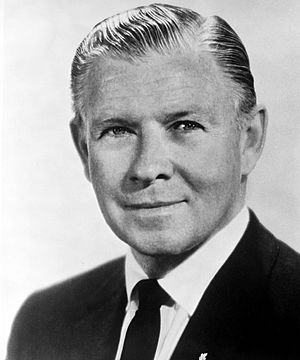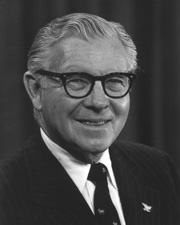George Murphy facts for kids
Quick facts for kids
George Murphy
|
|
|---|---|

Official portrait, 1964
|
|
| United States Senator from California |
|
| In office January 1, 1965 – January 2, 1971 |
|
| Preceded by | Pierre Salinger |
| Succeeded by | John V. Tunney |
| 7th President of the Screen Actors Guild | |
| In office 1944–1946 |
|
| Preceded by | James Cagney |
| Succeeded by | Robert Montgomery |
| Personal details | |
| Born |
George Lloyd Murphy
July 4, 1902 New Haven, Connecticut, U.S. |
| Died | May 3, 1992 (aged 89) Palm Beach, Florida, U.S. |
| Political party | Republican |
| Spouses |
Julie Henkel-Johnson
(m. 1926; died 1973)Betty Duhon Blandi
(m. 1982) |
| Children | 2 |
| Parents | Mike Murphy Nora Long |
| Education | Yale University (BA) |
George Lloyd Murphy (born July 4, 1902 – died May 3, 1992) was a famous American dancer, actor, and politician. He was known for his song-and-dance roles in many Hollywood musicals from the 1930s to the 1950s. George Murphy was also the president of the Screen Actors Guild from 1944 to 1946. He even received an honorary Oscar in 1951 for his contributions to film.
Later in his life, Murphy became a politician. He served as a U.S. Senator for California from 1965 to 1971. He was one of the first well-known actors to be elected to a major statewide office in California. Other actors like Ronald Reagan and Arnold Schwarzenegger followed his path. George Murphy is also the only U.S. Senator with a star on the famous Hollywood Walk of Fame.
Contents
George Murphy's Early Life
George Murphy was born in New Haven, Connecticut. His family was of Irish Catholic background. His father, Michael Charles "Mike" Murphy, was a well-known athletic trainer and coach. George went to Trinity-Pawling School, Peddie School, and Yale University. Before becoming an actor, he worked in different jobs. He was a tool maker for the Ford Motor Company, a miner, a real estate agent, and a dancer in nightclubs.
His Acting Career
In movies, George Murphy was famous for his dancing and singing. He appeared in many big musical films. Some of these include Broadway Melody of 1938 (1937), Broadway Melody of 1940 (1940), and For Me and My Gal (1942). He started his movie career in 1930, right after silent movies were replaced by "talkies." He retired from acting in 1952 when he was 50 years old. During World War II, he helped organize entertainment for American soldiers.
In 1951, George Murphy received a special Academy Award. This was an honorary Oscar, meaning it was given for his overall contributions, not for a specific role he was nominated for.
Beyond acting, he was important in the film industry. He was the president of the Screen Actors Guild from 1944 to 1946. He also worked as a vice president for companies like Desilu Productions and Technicolor. He even directed the entertainment for presidential inauguration events in 1953, 1957, and 1961.
Becoming a Politician
George Murphy started his political journey in 1952. He joined the leadership of the Republican Party in California. That same year, he also helped organize the entertainment for the inauguration of President Dwight D. Eisenhower and Vice President Richard Nixon.
In 1964, he was elected as a Republican to the U.S. Senate. He won against Pierre Salinger, who used to be the press secretary for President John F. Kennedy. Murphy became a Senator on January 1, 1965, and served until January 3, 1971. He actually started his term two days early. Salinger resigned so Murphy could gain more seniority, and the Democratic Governor Pat Brown appointed Murphy to finish the last two days of Salinger's term.
George Murphy was often asked to help other Republican candidates. For example, in 1966, he hosted a fundraiser in Atlanta, Georgia, for Bo Callaway, who was running for Governor of Georgia.
From 1967 to 1968, Murphy was the chairman of the National Republican Senatorial Committee. During his time as a Senator, he developed throat cancer. Part of his voice box (larynx) had to be removed. After this, he could only speak in a whisper for the rest of his life.
Murphy supported important civil rights laws. He voted for the Voting Rights Act of 1965, which helped protect the right to vote for all citizens. He also voted to confirm Thurgood Marshall to the U.S. Supreme Court and supported the Civil Rights Act of 1968.
In 1970, Murphy ran for re-election but lost to John V. Tunney. His health issues and strong support for the Vietnam War may have played a role in his defeat. There were also reports that he continued to receive a salary from Technicolor after becoming a Senator.
George Murphy's Legacy
George Murphy's journey from being an actor to a politician opened doors for others. Famous actors like Ronald Reagan and Arnold Schwarzenegger later followed his path into politics. Reagan even called Murphy his "John the Baptist," meaning Murphy paved the way for him.
Other Republicans admired Murphy's skill at speaking at fundraising events. This helped him become the chairman of the Senate Republican Campaign Committee.
During his time in the Senate, Murphy started a fun tradition: the Candy Desk. He placed a supply of candy on his desk on the U.S. Senate floor for other Senators to enjoy. This tradition has continued since 1971, with different Senators taking on the role of "keeper of the candy desk."
Family Life
George Murphy was married to Juliette "Julie" Henkel-Johnson, who was also his ballroom dancing partner. They were married from 1926 until her death in 1973. They had two children, Dennis Michael and Melissa Elaine. Later, he married Bette Blandi in 1982. They were married until his death in 1992.
Films
- Kid Millions (1934) as Jerry Lane
- Jealousy (1934) as Larry O'Roarke
- I'll Love You Always (1935) as Carl Brent
- After the Dance (1935) as Jerry Davis
- The Public Menace (1935) as Edward Joseph 'Red' Foster
- Woman Trap (1936) as Keat Shevlin
- Top of the Town (1937) as Ted Lane
- London by Night (1937) as Michael Denis
- Broadway Melody of 1938 (1937) as Sonny Ledford
- The Women Men Marry (1937) as Bill Raeburn
- You're a Sweetheart (1937) as Hal Adams
- Little Miss Broadway (1938) as Roger Wendling
- Letter of Introduction (1938) as Barry Paige
- Hold That Co-ed (1938) as Rusty
- Risky Business (1939) as Dan Clifford
- Broadway Melody of 1940 (1940) as King Shaw
- Two Girls on Broadway (1940) as Eddie Kerns
- Public Deb No. 1 (1940) as Alan Blake
- Little Nellie Kelly (1940) as Jerry Kelly
- A Girl, a Guy, and a Gob (1941) as Coffee Cup
- Tom, Dick and Harry (1941) as Tom
- Ringside Maisie (1941) as Skeets Maguire
- Rise and Shine (1941) as Mo McGonigle
- The Mayor of 44th Street (1942) as Joe Jonathan
- For Me and My Gal (1942) as Mo K. Metcalf
- The Navy Comes Through (1942) as Lt. Thomas L. 'Tom' Sands
- The Powers Girl (1943) as Jerry Hendricks
- Bataan (1943) as Lieut. Steve Bentley
- This Is the Army (1943) as Jerry Jones
- Broadway Rhythm (1944) as Jonnie Demming
- Show Business (1944) as George Doane
- Step Lively (1944) as Gordon Miller
- Having Wonderful Crime (1945) as Jake Justus
- Up Goes Maisie (1946) as Joseph Morton
- The Arnelo Affair (1947) as Theodore 'Ted' Parkson
- Cynthia (1947) as Larry Bishop
- Tenth Avenue Angel (1948) as Steve Abbutt
- Big City (1948) as Patrick O'Donnell
- Border Incident (1949) as Jack Bearnes
- Battleground (1949) as 'Pop' Stazak
- No Questions Asked (1951) as Inspector Matt Duggan
- It's a Big Country (1951) as Mr. Callaghan
- Talk About a Stranger (1952) as Robert Fontaine Sr.
- Walk East on Beacon (1952) as Inspector James 'Jim' Belden
- Deep in My Heart (1954) (scenes deleted)
Images for kids
See also
 In Spanish: George Murphy para niños
In Spanish: George Murphy para niños




